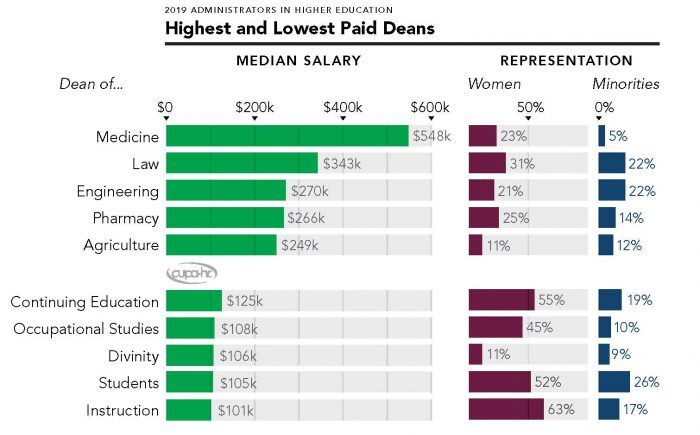Women and Minorities Lack Representation Among Highest-Paid Higher Ed Deans
Only 5 percent of deans of medicine in the nation’s colleges and universities are minorities. Women make up only a quarter of pharmacy deans, and only three in 10 law school deans are women. Among engineering deans, only about 20 percent are women or minorities.
Just-released findings from this year’s Administrators in Higher Education Survey show that women and minorities are woefully underrepresented among the highest-paid higher ed deans. Data showed that the top five highest-paid dean positions combined have 20 percent female representation, whereas the five lowest-paid dean positions combined are 47 percent female.
Representation of racial/ethnic minorities among deans also varies. The highest-paid dean position, dean of medicine, has the lowest representation of racial/ethnic minorities among all 42 dean positions surveyed. In contrast, minorities make up more than one-quarter of deans of students, which is one of the lowest-paid dean positions.

The research also shows that among deans, women of color are sometimes paid much less than or much more than their White male counterparts, depending on the discipline. For example, Black and Hispanic women are paid only $0.68 for dean of health-related professions and only $0.73 for dean of continuing education positions compared to White men, but earn $1.07 and $1.14 per White male dollar for dean of students and dean of law positions, respectively.
“Understanding representation in faculty leadership positions is a key first step to bridging the gap between hiring diverse faculty and ensuring that those faculty members rise to leadership roles at their institution,” says Adam Pritchard, Ph.D., senior survey researcher at CUPA-HR and author of the report. “Data like this can help higher education identify problem areas and better focus diversity and inclusion efforts.”
Other findings from the CUPA-HR 2019 Administrators in Higher Education Survey include:
- Salary increases. Overall administrator salaries increased by 2.7 percent for the 2018-19 academic year. The highest raises went to senior institutional officers (2.8 percent), and the lowest went to top executives (2.0 percent) and associate/assistant deans (2.0 percent).
- Representation of women and minorities. Women continue to make up about half (51 percent) of all administrators, the same as last year, and the percentage of racial/ethnic minority administrators has risen slightly to 16 percent this year, up from 15 percent last year. Some top administrative roles, such as chief diversity officer, employ a large percentage of Black and Hispanic women (52 percent), whereas other positions, such as chief facilities officer, are overwhelmingly occupied by White men (83 percent).
- Executive benefits. The number of institutions offering performance-based incentives increased this year, and fewer institutions are now offering deferred compensation as an executive benefit.
A total of 1,174 higher education institutions provided incumbent-level data for 50,880 administrators in 200 positions for this year’s survey. The survey collects data on salaries and demographics for each individual incumbent, allowing for more in-depth analysis and comprehensive benchmarking. Data collected include salary, sex, race/ethnicity, age, years in position and faculty status (for associate/assistant deans.)
CUPA-HR members can access the Administrators in Higher Education Report in the Compensation Programs/Plans Toolkit in the Knowledge Center.
For a list of participating institutions, an overview of the results, information on data collected and options for purchasing the survey report and DataOnDemand, visit the Administrators in Higher Education web page.


